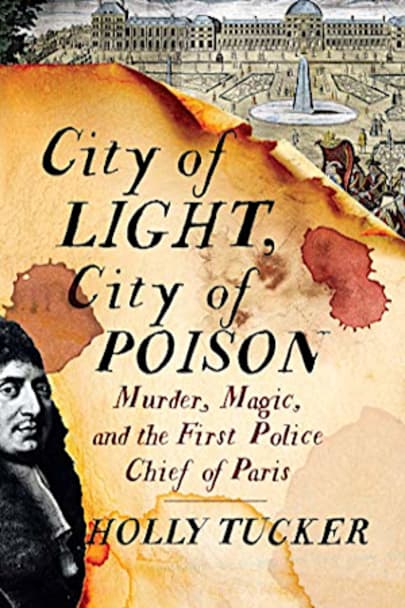In the late 1600s, Louis XIV assigns Nicolas de la Reynie to bring order to Paris after the brutal deaths of two magistrates. Reynie, pragmatic and fearless, discovers a network of witches, poisoners, and priests whose reach extends all the way to the king’s court at Versailles. Based on court transcripts and Reynie’s compulsive note-taking, Holly Tucker’s engrossing true-crime narrative makes … the characters breathe on the page as she follows the police chief into the dark labyrinths of crime-ridden Paris, the halls of royal palaces, secret courtrooms, and torture chambers.
more



This book is non-fiction, but it reads like fiction. History: you just can’t make this stuff up! Fascinating, well-researched, and well written, the book focuses on the “Affair of the Poisons”, which went on for four years in 17th century Paris. Paris was incredibly filthy, smelly, and murderous. Crime was rampant, intrigue and plotting were hobbies, and there was no centralized policing to be had.
“The new accessibility of pistols across social classes turned an already dangerous city into an even more deadly one…Parisians looking to protect their homes raced to buy handguns, making the city all the more unsafe.” Does that sound familiar, or what? This situation became worse: “In response to the rising violence, the Crown issued an edict in 1660 calling for the ban of all weapons including—and especially—handguns, by anyone other than soldiers, police officers, judges, and noblemen. The law did not have the desired effect.”
Enter one Gabriel Nicolas de la Reynie. He was an interesting first chief of police. Highly principled, but also ruthless and unmerciful, with no sympathy for the homeless. He set about cleaning up the city physically (by having the streets cleaned of mud and blood daily) as well as attacking crime. The use of poisons was popular, particularly among the nobility. Arsenic was the tool of choice, to the extent that La Reynie started treating it like we do the sales of antihistamines now: “Formal approval would be required for formulations such as arsenic or mercury chloride, necessary ingredients for certain trades such as goldsmiths and jewelers. A royal register would track all such sales.”
Eventually there were 150 imprisonments, some of whom were noble women. The scandals were the talk of the town and fodder for the tabloid press. I think there were eventually 34 executions, with many others being sent to the galleys or exiled. Interestingly, the French tortured people only after they were convicted, not before, but ensured they were still sufficiently alive to be aware of their execution.
The book also highlighted the excesses of the court of Louis XIV. The amount of money spent on himself and his large number of competing mistresses was enormous, and the luxuries they gave themselves are simply unimaginable. I’m off to read another of this author’s works.
Compelling narrative history that one again proves that truth is stranger than fiction.
A great insight into the inner workings of the Court of Louis XIV, and the royal efforts to deter crime in Paris.
Holly Tucker’s non-fiction book City of Light, City of Poison documents a lesser-known period of French history. While the events surrounding the French Revolution are well known and well-researched, Louis XVI’s ancestor presided over another turbulent era a hundred years before, and made efforts to establish the first system of law enforcement in the country.
In the second half of the 17th century, Paris was a place that, as Tucker writes, “assaulted the senses and rattled the nerves.” Fistfights, cutpurses, packs of stray dogs, streets increasingly jammed with carriages, and chamber pots being emptied from the windows onto unsuspecting passerby were daily occurrences.
But there were even darker forces at play. Pharaonic wealth of the aristocracy set against the backdrop of abject poverty of the masses gave rise to cabals of witches and poisoners who pushed magic and chemical substances that could help the rich get rid of rival and inconvenient spouses for the right price.
Convinced that his authority would suffer if he allowed his capital to continue falling into increasing chaos, Louis XIV, also known as the Sun King, appointed Nicolas de La Reynie the first lieutenant general of police. His task including cleaning up the city – but literally and figuratively – and he launched himself into it with gusto. Within months, the streets were cleaner and better lit, which in itself reduced the crime right away.
All the while, some high-profile members of the royal administration and even the royal family – including a prominent judge and Henrietta Anne, the king’s sister-in-law – continued dying in mysterious circumstances that suggested the use of poison. It was not long before La Reynie set his sight on a network of possible poisoners and began his investigations. What he discovered sent shockwaves through the court and forced Louis to step to cover up what could become a great embarrassment to the monarchy and him personally.
City of Light, City of Poison provides a glimpse into the life of 17th century Paris and the passions and greed that led many – both high and low-born – to commit unspeakable crimes. For a historical fiction author, it can also serve as a great source of background research and ideas for a novel.
Interesting read as you dive into the book and understand just how much time the author spent, on research, to authenticate her book.
Well-researched